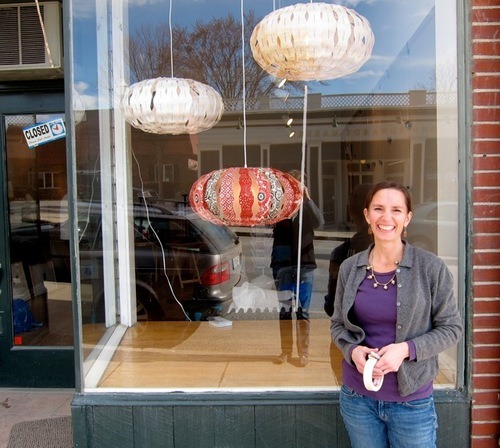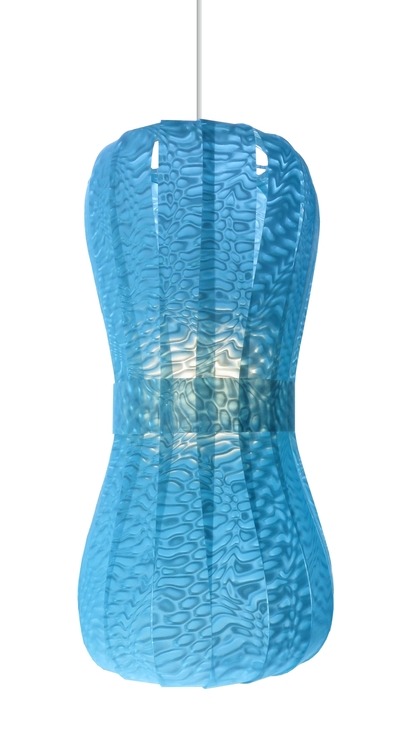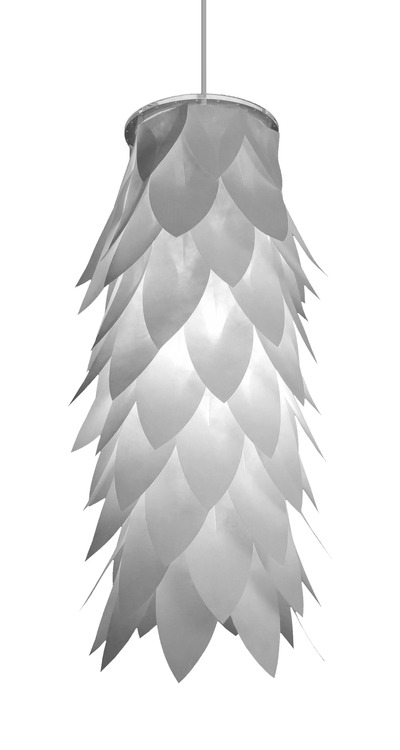
Meet our April 2014 LEAP finalist, lighting designer Julie Morringello! Julie’s beautiful works are perfect for brightening up a freshly spring-cleaned home and will be on sale in the SCC store through June 2014.?
SCC: Tell us about your work.
My background is in furniture design and woodworking, but a few years ago I felt the need to shake things up a bit in the studio and I decided to focus on making light fixtures. I consider lighting to be an extension of furniture, but with different functional requirements, which I find refreshing. Lighting offers me the opportunity to work with a wide variety materials and its scale is smaller, which has all kinds of practical advantages.
I make most parts of my lights by hand, using things like punches, razor blades and other specialized cutting tools, as well as large industrial machinery such as saws and sanders.? A few of the lamp components are laser cut, for which I create computer-generated drawings. I also use the computer for refining shapes and making templates, and for anything math- or scale-related.
Recently I’ve been experimenting with a variety of sheet goods, such as wood veneers, plastics, and non-woven fabrics.? One of the things I love about sheet goods is their potential for transformation. What at first seems floppy and two-dimensional can become something wonderfully sculptural.? The addition of light further emphasizes a sheet?s thinness and translucency, and adds another layer of transformation.
I try to find a balance between my desire to express a material’s sculptural qualities and the many practical considerations required to create a functional light fixture. My goal is to create what I think of as ?elegant solutions?.? A successful light, or any other object I make, will address a lot of competing aspects in a thoughtful and satisfying way ? both for myself, in relation to the process of creating it, as well as for the person who will own and use it.

SCC: Tell us about your training/education/special mentors.
As I child I loved to draw and to make things. I had a dollhouse, and I was so frustrated by the cost and poor design of the kits found at our local hobby shop that I started making my own furniture out of balsa wood. An architectural modelmaker and friend of my parents saw what I’d done and asked me to work for him, making trees for the models.? It was the best afterschool job ever.? When it was time to start thinking about college, one of the guys at the shop said, ?You should go to art school.?? I thought that sounded like a great idea.
When I took my first look at the Rhode Island School of Design furniture studio, I had a visceral reaction – I knew then and there exactly what I wanted to do.? Unfortunately at that time there was no undergraduate furniture program, so I majored in industrial design and spent as much of my time in the furniture studio as I could. Later on I did go back to get a graduate degree.? Rosanne Somerson, now the acting President of RISD, was an important mentor and friend, and she founded the hugely successful RISD undergraduate furniture program.
SCC: Why were you drawn to light fixtures?
I?m interested in the objects and the environments we build for ourselves; the useful items we make for living, our architecture and interior environments.? I like the relationship that furniture has to the human body and I enjoy working within (and sometimes intentionally outside of) those parameters.?

SCC: What inspires you?
I?m a materials junkie.? There?s nothing I like more than experimenting with a new material – discovering its strengths and weaknesses and figuring out what it wants to do or be, and then coming up with interesting ways to join one material to another…oh, and travel for sure. I recently spent three months in East Africa and that experience is going to keep me going for years…
SCC: What’s the best piece of advice you’ve received as a new artist?
Work hard and keep at it!
SCC: What advice do you have for others considering a career in the arts?
As a professional artist, designer, or craftsperson, your creativity is literally one of your most valuable assets. You musn?t neglect it. It?s important to figure out what feeds you and what you need to thrive, and be sure you take the time to do those things.

